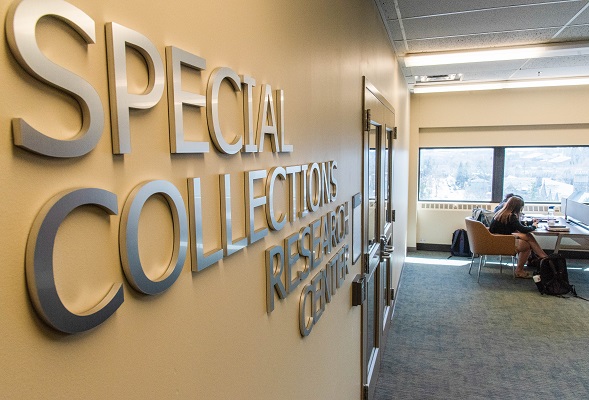This collection covers writing and correspondence from prominent journalist and screenwriter Ben Hecht, as well as materials related to his daughter, Jenny, and wife, Rose.
The Ben Hecht collection includes materials from the 1940s through 1963 and is divided into five series: Writing, Correspondence, Jenny Hecht, Rose Hecht, and Miscellaneous.
The Writing series, which comprises three-quarters of the collection, contains original manuscripts and notes authored by Hecht. The series is divided by genre into eight subseries: books, essays and articles, notes and treatments, poetry, published writing, scripts, short stories and miscellaneous. As most pieces are undated, materials within each subseries are arranged alphabetically by title as it appears on the piece. While the manuscripts included in the collection are generally for lesser-known or unpublished material, this collection provides a wealth of insight into Hecht's creative process. Particularly in the Scripts subseries, many works contain multiple drafts or include handwritten corrections.
The Books subseries contains a draft manuscript for Hecht's Perfidy (here titled Perfidy in Israel). Published in 1961, this controversial work reflected Hecht's growing anti-Zionism toward the end of his life, a stance that went against his earlier activism for Jewish causes. The Essays and Articles subseries holds five non-fiction pieces, including a letter criticizing the movie of The Diary of Anne Frank, for which Hecht's daughter Jenny was passed over for the title role.
Notes and Treatments includes a number of materials from Hecht's film and television work. Notable among these is a treatment for Miracle in the Rain, which was later produced as a film in 1956. Poetry consists of two poems that reflect some of Hecht's political views. Published Writing features an article Hecht wrote about Marilyn Monroe's death.
The largest collection of writing is contained in the Scripts subseries. It includes draft and final versions of nine separate projects, many with handwritten corrections. Not all were produced as films or plays, so these folders provide insight into some of Hecht's lesser-known work. Particularly interesting items in this subseries are the script for a musical version of Underworld, the screenplay for which Hecht won the first Academy Award for Best Original Story in 1927, and multiple drafts of Hecht's play Winkelberg, based on the life of his friend Maxwell Bodenheim.
Short Stories includes five examples of Hecht's fiction work, including handwritten pages for "Some Slightly Crazy People," which was published in the Saturday Evening Post in 1959. The final subseries in the Writings series , Miscellaneous, has untitled writings and jottings, including one written on a torn piece of cardboard and another on the back of an envelope.
The Correspondence series features materials reflecting Hecht's professional and personal life. Materials within the collection are divided in two subseries, Business Correspondence and Personal Correspondence, and arranged chronologically within each subseries. Spanning the years 1946 to 1963, with the bulk of material from 1958 to 1959, the relatively small Business Correspondence subseries contains a number of letters describing negotiations for projects involving people ranging from Orson Welles to Marilyn Monroe. Several are from Hecht's agent Albert Lewis. This series also includes a letter from the American Broadcasting System announcing the cancellation of Hecht's short-lived television talk show The Ben Hecht Show, which ran from September 1958 to February 1959.
Personal Correspondence spans 1946 to 1963 and is further divided into three subseries. The largest, Fan Letters, includes over 40 letters from fans written between 1956 and 1961. Most were written in support of Hecht's appearance on The Mike Wallace Show in February 1958. Two smaller subseries, Letters to Ben Hecht and Letters to Ben and Rose Hecht, include letters and telegrams from acquaintances, relatives, and family friends.
The Jenny Hecht series includes material related to Hecht's daughter's appearance in stagings of the theatrical version of The Diary of Anne Frank at the Palm Springs Playhouse and the Tappan Zee Playhouse in 1959. The folder includes Jenny Hecht's contracts for the appearances, programs for the productions, newspaper clippings, congratulatory telegrams from family friends, and a card which accompanied flowers from her father. The folder also includes photographs from the productions.
The Rose Hecht series features correspondence to and from Hecht's wife spanning from 1945 to 1959 and arranged chronologically. Several of the letters written by Rose indicate her involvement in her husband's business affairs, including a plea to a congressman petitioning for changes to the tax laws which "unfairly" burden artists.
The Miscellaneous series is comprised of two folders. The first folder contains a list of Hecht's visitors from 1950, featuring such Hollywood personalities such as Kirk Douglas, Otto Preminger, David O. Selznick, and Harpo Marx. The second folder includes publicity materials for several of Hecht's publications, a posthumously awarded certificate for induction to the Chicago Journalists Hall of Fame, two untitled hand-drawn floorplans, and a photograph of a children's band marked "Rhythm Band 1947."
